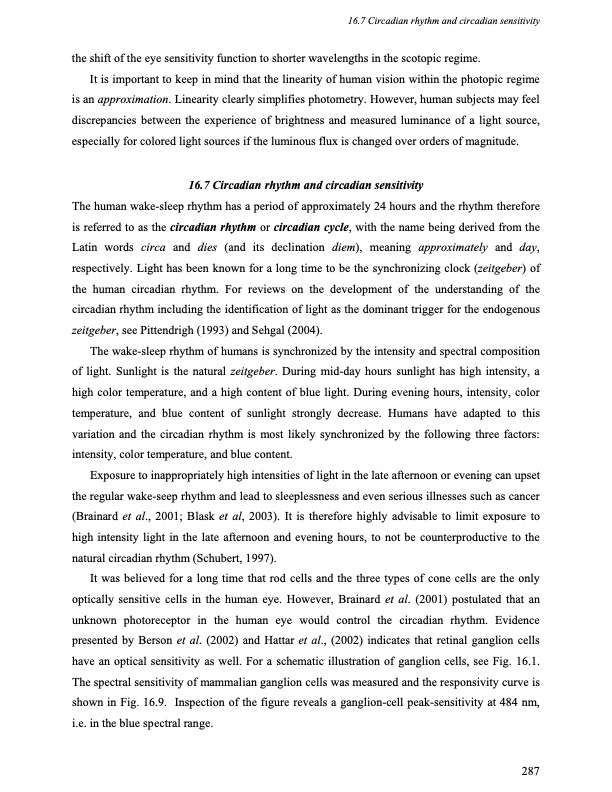
PDF Publication Title:
Text from PDF Page: 013
the shift of the eye sensitivity function to shorter wavelengths in the scotopic regime. It is important to keep in mind that the linearity of human vision within the photopic regime is an approximation. Linearity clearly simplifies photometry. However, human subjects may feel discrepancies between the experience of brightness and measured luminance of a light source, especially for colored light sources if the luminous flux is changed over orders of magnitude. 16.7 Circadian rhythm and circadian sensitivity The human wake-sleep rhythm has a period of approximately 24 hours and the rhythm therefore is referred to as the circadian rhythm or circadian cycle, with the name being derived from the Latin words circa and dies (and its declination diem), meaning approximately and day, respectively. Light has been known for a long time to be the synchronizing clock (zeitgeber) of the human circadian rhythm. For reviews on the development of the understanding of the circadian rhythm including the identification of light as the dominant trigger for the endogenous zeitgeber, see Pittendrigh (1993) and Sehgal (2004). The wake-sleep rhythm of humans is synchronized by the intensity and spectral composition of light. Sunlight is the natural zeitgeber. During mid-day hours sunlight has high intensity, a high color temperature, and a high content of blue light. During evening hours, intensity, color temperature, and blue content of sunlight strongly decrease. Humans have adapted to this variation and the circadian rhythm is most likely synchronized by the following three factors: intensity, color temperature, and blue content. Exposure to inappropriately high intensities of light in the late afternoon or evening can upset the regular wake-seep rhythm and lead to sleeplessness and even serious illnesses such as cancer (Brainard et al., 2001; Blask et al, 2003). It is therefore highly advisable to limit exposure to high intensity light in the late afternoon and evening hours, to not be counterproductive to the natural circadian rhythm (Schubert, 1997). It was believed for a long time that rod cells and the three types of cone cells are the only optically sensitive cells in the human eye. However, Brainard et al. (2001) postulated that an unknown photoreceptor in the human eye would control the circadian rhythm. Evidence presented by Berson et al. (2002) and Hattar et al., (2002) indicates that retinal ganglion cells have an optical sensitivity as well. For a schematic illustration of ganglion cells, see Fig. 16.1. The spectral sensitivity of mammalian ganglion cells was measured and the responsivity curve is shown in Fig. 16.9. Inspection of the figure reveals a ganglion-cell peak-sensitivity at 484 nm, i.e. in the blue spectral range. 16.7 Circadian rhythm and circadian sensitivity 287PDF Image | Human eye sensitivity and photometric quantities

PDF Search Title:
Human eye sensitivity and photometric quantitiesOriginal File Name Searched:
human-eye-sensitivity.pdfDIY PDF Search: Google It | Yahoo | Bing
Cruise Ship Reviews | Luxury Resort | Jet | Yacht | and Travel Tech More Info
Cruising Review Topics and Articles More Info
Software based on Filemaker for the travel industry More Info
The Burgenstock Resort: Reviews on CruisingReview website... More Info
Resort Reviews: World Class resorts... More Info
The Riffelalp Resort: Reviews on CruisingReview website... More Info
| CONTACT TEL: 608-238-6001 Email: greg@cruisingreview.com | RSS | AMP |